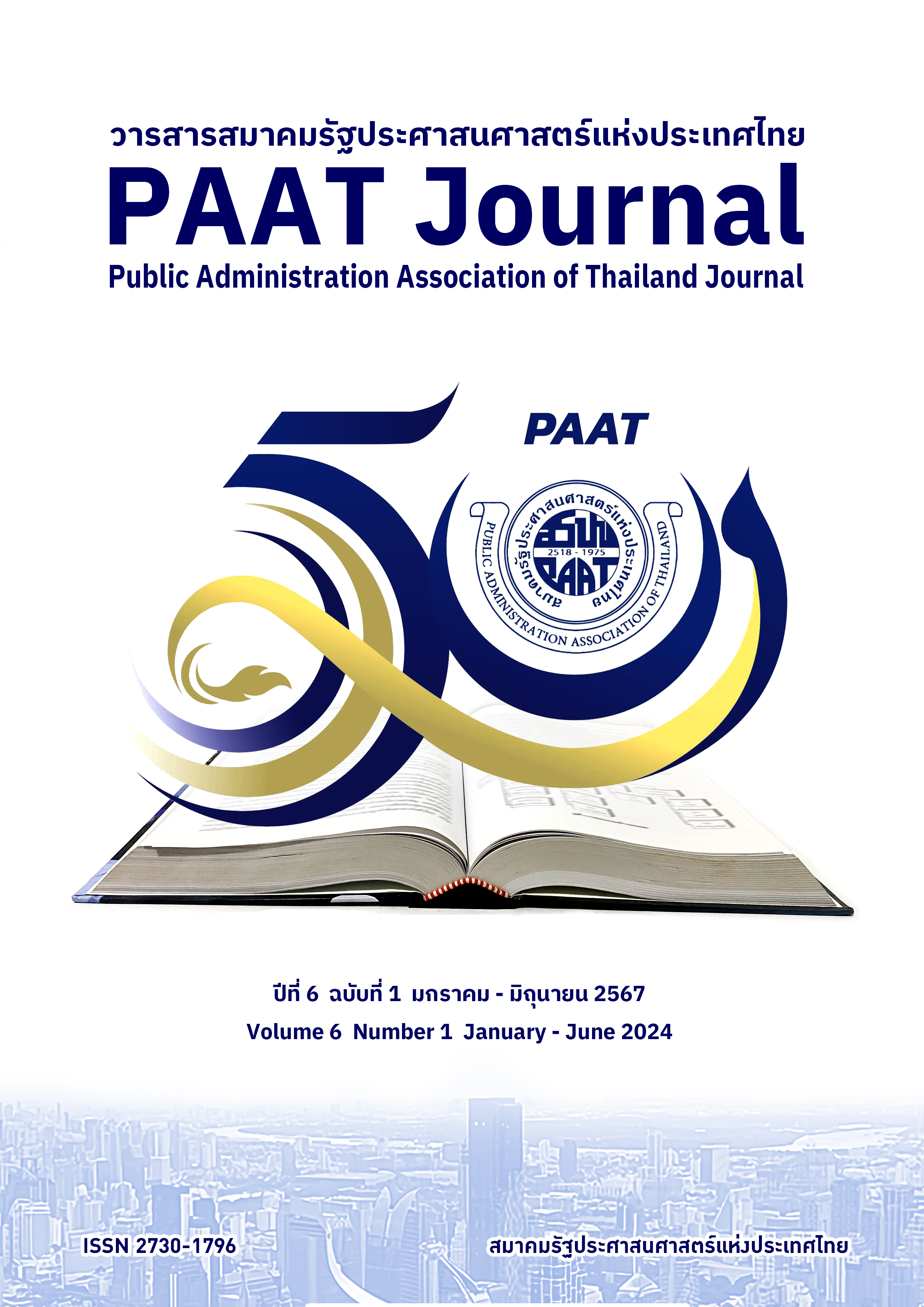ํ้The The Pattern of Management towards to the Just City Model on Tackling the PM 2.5 Issues in Thailand
Keywords:
Management, Management; The Just City Model; PM 2.5 Issues in Thailand, PM 2.5 Issues in ThailandAbstract
The initial purpose of this academic article is to analyze conditions and issues on the quantity of PM 2.5. Second purpose is to study the pattern of management towards to the Just City Model on tackling the PM 2.5 issues in Thailand. The said purpose will build up more suggestions on the pattern of management towards to the Just City Model. The methodology conducted in this article is literature reviewing from news, articles, journals and related researches. The results on this study found that PM 2.5 conditions were caused by burning in open-air space, exhaust emission from traffic and industry and PM 2.5 blowing across from neighboring countries. These mentioned triggered quality of life and health to all humanity. The Just City Model has three pivotal pillars: (1) Equity, as seen from the government’s policy implementation did not elucidate any equity to the socially vulnerable people, (2) Diversity, the zero-burn policy implemented by the government was still understood differently by different groups of people in society, and (3) Democracy-- in this circumstance, democracy was still not related to decentralization and people’ participation. In conclusion, the government should consider the limit of capacity on socially vulnerable people and promote local community to participate in imposing area development guidelines with other community equally. Apart from that the government should create incentive measures for farmers to find out alternative way instead of burning to cause PM 2.5. The acceptance on diversity should be also managed through local wisdom. Decentralization should be practiced in department of local administration. Business sector must take part in monitoring and conserving ecosystem because they are the one who emit pollutions, while public sector must mutually participate in mitigating air pollution so as to propel the country to be in good quality of environment and be equity in every dimension of society.
References
รัฐธรรมนูญแห่งราชอ่าณาจักรไทยพุทธศักราช 2560. (6 เมษายน 2560). ราชกิจจานุเบกษา. เล่ม 134 ตอนที่ 40 ก หน้า 1-90.
United Nations Thailand. (2021). The Global Goals for Sustainable Development. https://www.un.or.th/globalgoals/th/the-goals/
สำนักเลขาธิการนายกรัฐมนตรี. (2566). สธ. เผย 15 จังหวัดค่าฝุ่น PM 2.5 สูงติดต่อกัน 3 วัน ตั้งแต่ต้นปีพบผู้ป่วยแล้ว 1.32 ล้านคน คาดสัปดาห์นี้ กทม.-ปริมณฑลแนวโน้มดีขึ้น. https://www.thaigov.go.th/news/contents/details/65877
กรมควบคุมมลพิษ. (2566). ยกระดับในการป้องกันและแก้ไขปัญหามลพิษจากฝุ่นละออง ในช่วงสถานการณ์วิกฤต. https://www.pcd.go.th/pcd_news/29162
กลุ่มเฝ้าระวังฝุ่น จุฬาลงกรณ์มหาวิทยาลัย. (ม.ป.ป.). เรียนรู้อยู่กับฝุ่น PM 2.5. https://www.chula.ac.th/wp-content/uploads/2019/10/Chula-PM25.pdf
Woods, K. (2015). CP maize contract farming in Shan State, Myanmar: A regional case of a place-based corporate agro-feed system. BRICS Initiative for Critical Agrarian Studies.
Roberts, S., Arseneault, L., Barratt, B., Beevers, S.,Danese, A., Odgers, C., Fisher, H. (2019). Explorationof NO2 and PM2.5 air pollution and mental health problems using high-resolution data in London-based children from a UK longitudinal cohort study. Psychiatry Research, 272, 8-17.
SDG MOVE. (2020). การแก้ไขปัญหา PM 2.5 อย่างยั่งยืน: เมื่อการสร้างความตระหนักไม่เพียงพอ. https://www.sdgmove.com/2019/10/11/bangkok-pm-2-5/
Fainstein, S. S. (2010). Redevelopment Planning and Distributive Justice in the American Metropolis. Available at SSRN 1657723.
สำนักสนับสนุนประชากรกลุ่มเฉพาะ. (2565). กลุ่มชาติพันธุ์กับป่า รักษาวิถีชีวิตคู่กันได้อย่างไรในภาวะ PM 2.5. https://section09.thaihealth.or.th/2022/08/12/กลุ่มชาติพันธุ์กับป่า-ร/
สถาพร พงษ์พิพัฒน์วัฒนา. (2566). “การพัฒนาทางเลือก” ข้อเสนอแก้ปัญหาฝุ่น PM 2.5 ที่เริ่มด้วยการมอง “คน” เป็นศูนย์กลาง. https://www.tijthailand.org/th/article/detail/transboundary-haze-pollution-and-alternative-development
ศิขรินทร์ ศรีสุข. (2563). มาตรการทางกฎหมายในการแก้ไขปัญหามลพิษทางอากาศและฝุ่นละออง PM 2.5 จากภาคธุรกิจ กรณีศึกษา การเผาในพื้นที่เกษตรภายใต้ระบบเกษตรพันธสัญญา (การศึกษาค้นคว้าอิสระปริญญาโท). มหาวิทยาลัยธรรมศาสตร์.
พิพัฒน์ เหลืองนฤมิตชัย. (2019). วิกฤตฝุ่นในมุมเศรษฐศาสตร์ : สิทธิในอากาศสะอาดควรเป็นของประชาชน. https://www.the101.world/right-to-breathe-clean-air/
Burayid, M. (2000). Urban Planning in a Multicultural Society. An Imprint of Greenwood Publishing Group Inc.
มาลี สิทธิเกรียงไกรและคณะ. (2021). ภูมิปัญญาท้องถิ่นกับการจัดการไฟ (ป่า) ความมั่นคงทางอาหาร และสุขภาวะสังคม. (Proceeding). ใน รายงานการประชุมวิชาการและการนำเสนอผลงานระดับชาติ Engagement Thailand ครั้งที่ 7. (2-3 September 2021). 491-495.
Thai PBS. (2566). กรมควบคุมมลพิษ รับมาตรการจัดการไฟป่าไม่สอดรับวิถีไร่หมุนเวียน. https://theactive.net/news/pollution-20230201/
บวรศักดิ์ อุวรรณโณ และถวิลวดี บุรีกุล. (2552). ประชาธิปไตยแบบมีส่วนร่วม (พิมพ์ครั้งที่ 4). สถาบันพระปกเกล้า.
TDRI. (2023). ข้อจำกัดในการแก้ไขปัญหาฝุ่น PM 2.5. https://tdri.or.th/2023/03/pm2-5-thailands-solutions/
มหาวิทยาลัยมหิดล. (2564). แนวทางการแก้ปัญหาฝุ่น PM 2.5 ที่เป็นรูปธรรมในสายตาประชาชน. https://www.ph.mahidol.ac.th/news/10012022/
The ASEAN Secretariat Jakarta. (2022). Executive Summary of the Final Review of the Roadmap on ASEAN Cooperation towards Transboundary Haze Pollution Control with Means of Implementation. ASEAN Secretariat.
Downloads
Published
How to Cite
Issue
Section
License
Copyright (c) 2024 PAAT Journal

This work is licensed under a Creative Commons Attribution-NonCommercial-NoDerivatives 4.0 International License.


